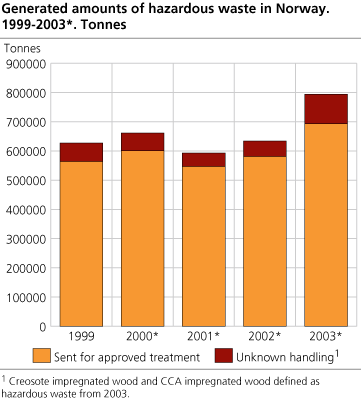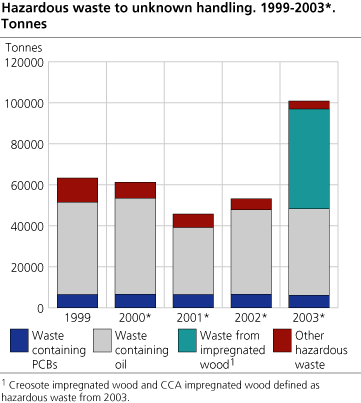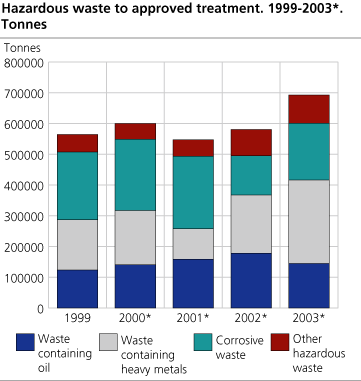Content
Published:
This is an archived release.
Hazardous waste astray - far from target
Hazardous waste that has gone astray is a priority field for the environmental authorities. Their goal is to get nearly all of this waste to undergo environmentally sound treatment. Still 100 000 tonnes of toxic waste, equalling 5 000 truckloads, is outside of control every year.
Almost 800 000 tonnes of hazardous waste were generated in Norway in 2003, according to preliminary figures from Statistics Norway. Of this, close to 700 000 tonnes was delivered to approved handlers, leaving 100 000 tonnes outside of the approved handling system. Half of the uncontrolled handling is due to new types of hazardous waste, but older types like windows with PCB and waste oil still amounts to significant amounts.
More to environmentally sound treatment
About 690 000 tonnes of hazardous waste were sent for approved treatment in 2003, increasing from 560 000 tonnes in 1999. The increase in amounts treated can be due to increased generated amounts; another reason can be increasingly effective collection of the waste. Most of the increase came the last year. Closer descriptions of trends and details can be expected when final figures are published.
Unknown handling doubled
The amount of hazardous waste outside the approved handling system has doubled from 2002 to 2003, totalling 100 000 tonnes. The increase is due especially to a change in the classification of hazardous waste, defining certain types of impregnated wood (creosote and CCA) as hazardous. Most impregnated wood waste is today incinerated at plants for ordinary waste, which is illegal. However, recent studies reveal that this kind of treatment does not pollute beyond the levels from incineration of ordinary waste.
The most serious pollutants are PCBs that are contained in windows. About 7 000 tonnes of these windows are discarded every year. About 6 000 tonnes are not sent for proper treatment, which equals 10 000 kg of PCB. Other kinds of waste containing PCBs are to a large extent handled as prescribed.
Annually, oily waste amounts to 200 000 tonnes, of which 40 000 tonnes are not handled as prescribed. A return scheme provides free delivery of clean waste oil, achieving a return on amounts converted to pure oil of about 80 per cent.
|
Selected types of hazardous waste. Total amounts, approved
handling and unknown handling. 2003*. Tonnes |
| Material | Total | To approved treatment | To unknown handling | ||||||||||||||||||||||||||||||||||||
|---|---|---|---|---|---|---|---|---|---|---|---|---|---|---|---|---|---|---|---|---|---|---|---|---|---|---|---|---|---|---|---|---|---|---|---|---|---|---|---|
| Total | 245 087 | 148 215 | 96 872 | ||||||||||||||||||||||||||||||||||||
| Containing PCB (windows) | 7 000 | 1 009 | 5 991 | ||||||||||||||||||||||||||||||||||||
| Containing PCB (other) | 600 | 532 | 68 | ||||||||||||||||||||||||||||||||||||
| Containing oil | 187 487 | 145 301 | 42 186 | ||||||||||||||||||||||||||||||||||||
| Impregnated wood (CCA) | 15 000 | 1 008 | 13 992 | ||||||||||||||||||||||||||||||||||||
| Impregnated wood (creosote) | 35 000 | 365 | 34 635 | ||||||||||||||||||||||||||||||||||||
Other wastes of high priority
Brominated flame retardants (BFR) appear to be a problem that we are only now starting to understand its severity. Waste containing BFR now has high priority from the authorities. This kind of waste, however, was not defined as hazardous until 1/1-2004 and is therefore not included in the statistics above. The amounts of waste exceeding the new limits for hazardous waste are roughly estimated to 2 000 to 4 000 tonnes per year, and originates from circuit boards and plastic covers from waste electrical and electronic equipment (WEEE). Additionally about 50 000 tonnes from soft parts of cars and WEEE, not exceeding the limit, arises yearly. The amounts converted to pure BFR is estimated to 200 to 250 tonnes per year, of which more than half is collected through a return scheme for WEEE.
Tables:
- Table 1 Total amounts of hazardous waste, by handling. 1999-2003*. Tonnes
- Table 2 Hazardous waste to unknown handling, by material. 1999-2003*. Tonnes
- Table 3 Hazardous waste to approved handling, by material. 1999-2003*. Tonnes
- Table 4 Hazardous waste to approved handling, by industry. 1999-2003*. Tonnes
Additional information
Approved treatment as applied in this article includes only hazardous waste generated in Norway (export is therefore included, while import is excluded).
Contact
-
Gisle Berge
E-mail: gisle.berge@ssb.no
tel.: (+47) 48 12 19 97
-
Terje Lorentzen Landsem
E-mail: terje.landsem@ssb.no
tel.: (+47) 98 84 31 39



